Hi folks,
We’ll be meeting this coming Wednesday, April 17th from 7 to 9 pm in the Community Room in the SE corner of McMenamins Kennedy School. Here’s the draft agenda:
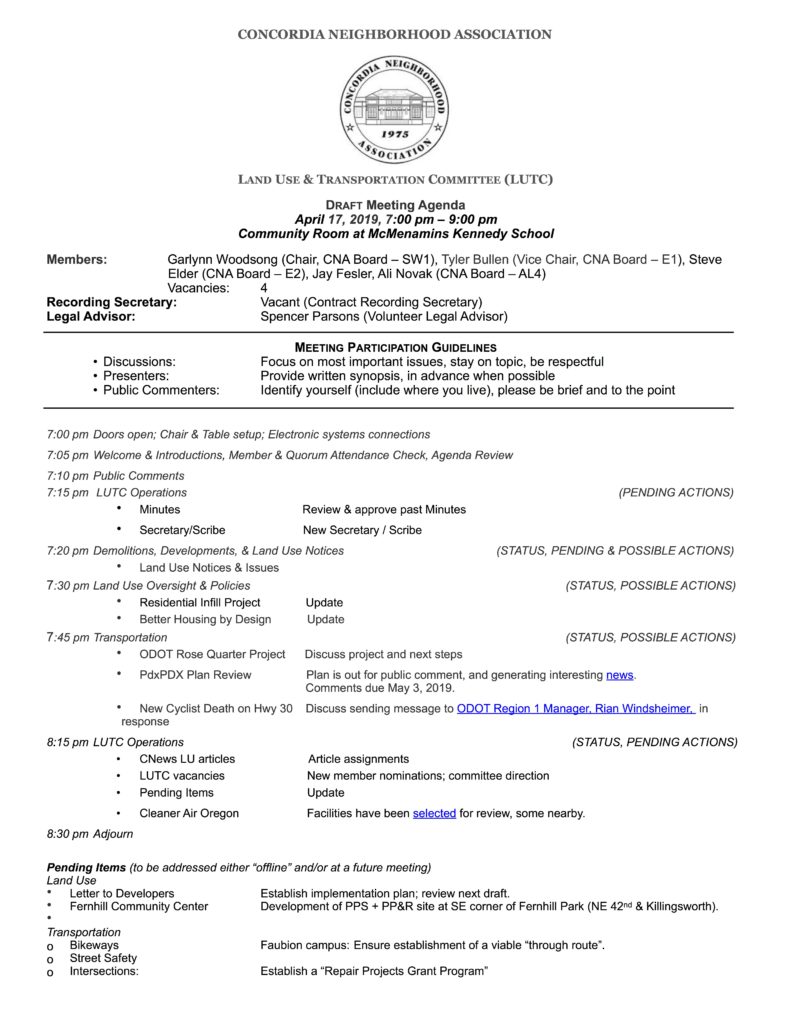
See you there!
cheers,
~Garlynn
By Doug Decker | Historian
The question: We live on 35th and Ainsworth in a home built in 1941 and – like the rest of our neighbors between 33rd and 37th circling the blocks of Ainsworth and Simpson – we all have lots 50 by 230 feet. Why do you suppose the lots on this block were platted so long?
– Rose and John Yandell

The historian reports: The long, narrow configuration of this block stems from decisions made more than 100 years ago by John D. Kennedy. He once owned much of the property between Killingsworth and Ainsworth streets, and 33rd and 42nd avenues, and Kennedy School was named for him.
The Irishman immigrated to Oregon in 1866, found his way to Baker City and worked in and then owned a dry goods store.
After coming to Portland about 1881, Kennedy bought this property, originally part of the 1855 Isaac Rennison Donation Land Claim. It was outside the city limits and far from any developments.
Kennedy was ahead of his time in the market. Northeast Portland’s ripeness for real estate didn’t take place until the years after the 1905 Lewis and Clark Exposition, when it seemed anyone who could was buying property or building houses.
But Kennedy had platted these lands as the Kennedy Addition back in 1890, a grid of 15 square blocks with more than 200 lots. Two years later, he platted Kennedy’s Second Addition, adjacent to the east, with room for another 120 homes.
Several other nearby plats were filed about that time, but they were also just lines on paper. There was no market yet for residential development. So, in 1906, city council approved his petition to “vacate” five of the blocks in his addition. That officially eliminated platted streets, even if they didn’t yet exist – like all of the north-south streets in the block between Ainsworth and Simpson, from 33rd east to 37th.
Kennedy’s stated rationale was to sell the larger chunk of land as acreage for farm fields.
As urbanization spread in the years that followed, neighborhoods were built to the north, south and west, but the 12-acre parcel – with no north-south through streets – stayed as one big block in farm use.
Kennedy died in December 1936. In 1938 the property was controlled by Ward D. Cook, a Portland insurance and real estate agent, who designated 80 lots on the long block ready for construction.
After World War II the market truly picked up. Most of the houses were built and sold between 1940 and 1950.
So there you have it. In the original Kennedy’s Addition plat, that one long block was going to be five blocks. But then Kennedy did away with the blocks to better sell the property, which he never did.
The market came and went and came back again. Then another speculator saw opportunity and turned the island of farm into the more than 50 lots there today, most of them a very long and narrow quarter-acre each. Read more and check out maps and historic aerial photos on this topic at AlamedaHistory.org.
Ask the historian is a CNews standing feature that encourages readers to ask questions about the history of the neighborhood and its buildings. Is there something you’ve wondered about? Drop a line to CNewsEditor@ConcordiaPDX. org and ask Doug Decker to do some digging.
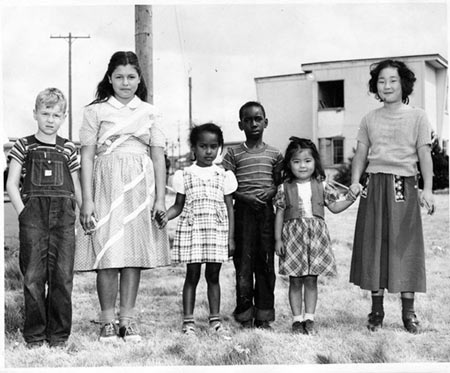 The 2019 Vanport Mosaic Festival returns for its fourth event May 21-June 2, organized by community-driven nonprofit Vanport Mosaic.
The 2019 Vanport Mosaic Festival returns for its fourth event May 21-June 2, organized by community-driven nonprofit Vanport Mosaic.
“Through exhibits, documentary screenings, tours, performances and dialogues, we will celebrate the lessons of resilience and resistance as defined and told by historically oppressed communities,” reported the festival’s Facebook page.
The multi-disciplinary festival has received the Oregon Heritage Excellence Award, the Spirit of Portland Award and the Columbia Slough Watershed Council’s Achievement Award. Returning sponsors and funding sources are Oregon Historical Society, Portland Bureau of Emergency Management, Multnomah County Drainage District, Port of Portland, Regional Arts & Culture Council and Multnomah County Cultural Coalition.
The festival is seeking more sponsors, funders and volunteers. For details, contact Info@VanportMosaic.org or visit Facebook.com/events/318232912147588.
Photo courtesy of Vanport Mosaic Festival, Oregon Historical Society digital file no. ba018658

Concordia University (CU) in February received the largest financial contribution in its 114-year history.
The $5 million grant from the Robert D. and Marcia H. Randall Charitable Trust will establish the Robert D. Randall Endowed Chair for Business and Technology.
According to university officials, that chair will expand the CU School of Management’s focus on an innovative business education and technology program.
“This gift will be transformative in advancing Concordia’s commitment to developing ethical and impactful leaders,” said Michelle M. Cowing, Ph.D., school of management dean.
“Concordia Portland will continue its long history of innovative partnerships to solve difficult societal and business challenges throughout the Pacific Northwest.”
The focus for the business & technology program is driven by the unique makeup of the regional economy, she added. It’s one fueled by homegrown businesses as well as global enterprises.
A new clinical model and technology curriculum will be co-designed with regional business leaders working in small and large businesses alike, startups and the growing tech sector.
According to the dean, engaging students in a variety of clinical experiences and a strong technology emphasis will prepare future leaders who are able to help businesses respond to ever-increasing economic and technological change.
The $5 million grant kicks off a university campaign to raise an additional $1.25 million. That’s also for the university’s business program, which is now named the Randall Fellows Clinical Program for Business & Technology.
By Karen Lotts | CNA Media Team
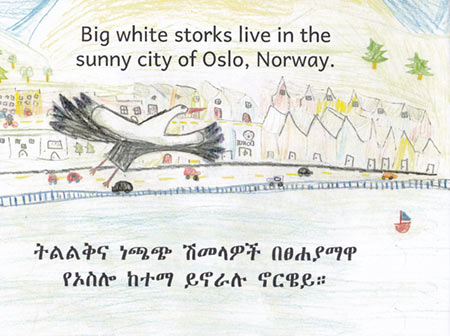
A group of Vernon Elementary School students are officially published illustrators thanks to a collaboration between their fourth grade classes and authors/Ethiopian literacy advocates Jane and Caroline Kurtz.
The students’ drawings appear in the children’s book “Home,” written by the Portland-based Kurtz sisters. It tells a story of immigration framed in a tale about white storks that migrate annually from Europe to Ethiopia.
The text is written in both English and Amharic, one of the three main languages spoken in Ethiopia.
According to the sisters, who grew up in Ethiopia, children’s literature is just taking root in that country. There are still limited options for beginner books that both appeal to children and are written in Ethiopian languages.
To help meet this need, Jane co-founded the nonprofit Ethiopia Reads 20 years ago and in 2016 began writing stories for Ethiopian children learning to read. Jane and Caroline now volunteer as creative directors for Ready Set Go Books, a project of the Seattle-based nonprofit Open Hearts Big Dreams.
They have collaborated previously with community volunteer illustrators through churches or community college art programs. The project with Vernon came to life last spring when teacher Marie McMahon asked the sisters if they’d be interested in her students contributing to their next book.
“When my students heard that they could be a part of making a difference in other children’s lives by increasing access to literacy, they were immediately on board,” Marie said.
During a presentation at Vernon, Jane and Caroline spoke to the students about growing up and going to school in Ethiopia and the importance of these books to the young readers there.

In the pursuit of authenticity, the students then researched Ethiopian landscapes and white storks before meeting with volunteer illustrator Jordy Farrell, from Ready Set Go Books, who offered illustration tips.
Using additional background art from a previous collaboration with students in Beaverton and combining it with the illustrations from Vernon students, a colorful book was ready to be published online and printed in Ethiopia.
The Vernon community has reacted warmly to the philanthropic project, and gathered recently at Cafe Eleven for the debut of the book and copies signed by the student illustrators.
“As a published author, I face incredible odds…a hard craft journey…and the payoff is in seeing readers connect with my books,” Jane said. “I think something similar happened with these students.”
The books are available through Amazon.com. Involvement opportunities can be found via EthiopiaReads.org and OpenHeartsBigDreams.org.
Karen Lotts is a local freelance writer who helps local small businesses and nonprofits connect with their audiences through copywriting. She can be reached at KarenLotts.com.
By Garlynn Woodsong | Chair, CNA LUTC
A few years ago, the city of Portland solicited feedback from the Concordia Neighborhood Association (CNA) about the 20s Bikeway project.
One of our responses was to request diverters at major streets in our neighborhood – such as Prescott and Killingsworth – to prevent cut-through car traffic from turning onto the narrow one-lane streets on which the 20s Bikeway is routed. That practice can stress out potential bicyclists on the route who may be interested in bicycling more, but are concerned for their safety.
But we were told the city would only install diverters on streets with higher than a certain amount of automobile traffic.
They then informed us they had changed their policies, and now they only installed diverters on streets with sufficiently high traffic volumes. They measured the traffic volumes in Concordia, and the single-lane streets of the 20s Bikeway project didn’t have enough cars to meet their new standard (for two-lane streets), so therefore they didn’t feel diverters were necessary.
I’ve told this story to folks around the city. In doing so, I’ve found a coalition of folks who also want to see physical diversions installed to protect our investment in the bicycle greenway system and keep it safe for bicyclists of all ages and abilities.
Together we developed a communitybased policy proposal called “Diversion on Bikeways as Urban Form.” The basic concept is that the urban form of bicycle greenways should include diverters to ensure that they are local-access-only for motor vehicles, while allowing bicycles to continue as through traffic.
The idea is the same as the existing urban form standard for sidewalks that includes wheelchair ramps where sidewalks meet street intersections, and for driveways that includes ramps and aprons where driveways meet streets.
This policy proposal is endorsed by CNA, the Northeast Coalition of Neighborhoods, SE Uplift and BikeLoudPDX.
Those groups presented this policy proposal to Portland Bureau of Transportation (PBOT) staff in December. We were told PBOT will take no further action until it fills its new greenways coordinator position.
Once this policy is adopted officially, it includes a strategy to deploy temporary installations initially to test each diverter location. It advises using kiosks to allow neighbors to provide feedback to PBOT, so temporary installations can be moved or adjusted, retested and perhaps moved and tested again, before being made permanent.
This sort of iterative public feedback loop is proposed as a more effective version of public engagement.
Traditionally, public engagement involves discussions in meeting rooms far from actual installation sites. Feedback thus received comes from people who haven’t yet interacted with the physical diversions in question as a part of their daily travels.
We look forward to working with the city to test this new policy to help encourage more bicycling in Portland – in a way that is respectful of and responsive to the concerns of neighbors and roadway users.
Garlynn Woodsong lives on 29th Avenue, serves on the CNA board and is an avid bicyclist. He also is a dad who is passionate about the city his son will inherit. He is the planning + development partner with Cascadia Partners LLC, a local urban planning firm. Contact him at LandUse@ ConcordiaPDX.org.
By Nancy Varekamp | CNews Editor
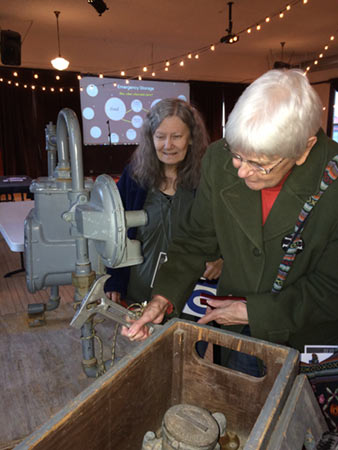
“When you have something that’s unregulated and there’s tons of fear, there are all sorts of placebos,” said Tim Cook, NW Seismic structural consultant.
He told participants at the recent, local Neighborhood Emergency Preparedness Expo to be careful about making – or hiring – residential seismic retrofits. F
ollowing the event, Tim explained there’s no code for installing anchors to hold an existing home to its foundation during an earthquake. New home construction codes offer some reference for builders. And forensic engineering studies of homes damaged by earthquakes offer evidence-based criteria for optimum retrofit methods.
“It’s not rocket science, of course, but there are a lot of nuances,” he reported. Tim has been involved in the retrofit industry for six years, now working for a company that traces its roots to the Spring Break Quake in the 1990s.
“There’s no education required to do seismic reinforcement. We see a lot of engineering that people are paying for that isn’t going to work,” he said.
A survey in the San Francisco Bay area – ground zero in terms of industry knowledge – found 80 percent of the residential retrofits inspected probably won’t be effective.
“In this way, this is really embarrassing to the industry,” Tim noted.
Websites can provide both good and bad information. Tim pointed to the site maintained by the city of Salem Building & Safety Division. It recommends hardware designed to resist uplift forces generated by wind, rather than the lateral forces generated by earthquakes.
“If city inspectors don’t understand this, why would contractors go out of their way to learn the basics?” Tim asked.
He has these suggestions for DIYers and/or those who plan to hire contractors:
“Just keep digging deep and asking questions until you’re comfortable to make decisions,” Tim advised. “Above all, remember this business is fussy enough,” he added. “We recommend contractors do only seismic. If they do insulation, they shouldn’t do seismic. It’s not a recipe for success.”
Nancy Varekamp is semiretired from her career in journalism, public relations and – her favorite work engagement – writing and editing targeted newsletters
Below are the poetry efforts of three Faubion School fourth graders in Mr. McGee’s class.
Clouds
By, Genevieve
Clouds have emotions like we do. They rain
on people and they don’t care who. Clouds
have rainbows, hair clips and ties. Sometimes
clouds are nice and make shapes in the sky.
They also make storms while our hearts
flutter high above the clouds. No storms, no
rainbows, no rain or grey skies. Sometimes no
clouds to be seen. No rainbows or storms, no
emotions or feelings, just calm and clear…
but something is near. Clouds just come
again.
Portland is a home of clouds, they come
and go, it’s quite the show. When clouds are
excited, BOOM! Thunder or lightening all
pour through the sky. Clouds love emotions
just like you and me. Sometimes it’s better to
leave them in peace.
Untitled
By, Clover
When I shiver in fear at night, I think what
will happen to our world. Then I think of
Faubion school. The way I feel cool, they
way my school is unique. Unique as in
feminism. Amazing people who stand up
and girls that run the playground and then
I don’t feel that bad.
Feminist
By, Grace
I can do this.
I can show this to people who do not
believe in women’s rights. People who do
not believe in feminism. I grab my sign and
go out to the road chanting, screaming,
while the rain pours down on my cold, wet
body. Thank you Earth, Thank you for all of
the people who are feminists. Thank you.
By Karen Wells | CNA Media Team
February’s not a time for thinking of sunscreen or how to avoid sunburn. Scattered sunny days are celebrated with bare arms and legs. No need to cover up, scout for shade or sunscreen.
Unfortunately, the makers and advertising teams of major brands of sunscreen project the illusion that sunscreen is primarily used to protect pale skin from the sun’s damaging omnipresent rays.
Sunscreen protects everybody’s skin. All shades of skin – from pale to dark – need a healthy layer of sunscreen when summer’s hot sun shines. That’s right, people with dark skin do sunburn.
How do you ask your dark-skinned neighbor, nice person, African American, which sunscreen product do they use? Or how do you respond if your child asks you if a dark-skinned friend needs to put on sunscreen before they race off to the swings?
You might feel awkward about asking. You might feel embarrassed by the question.
These examples, on the surface, might appear to fall in the category of cross cultural differences. Closer examination reveals that the questions are actually about skin care and avoiding sunburn and skin cancer.
We all ask questions to show concern or interest. Showing concern or interest in the well-being of others builds friendships and community.
Asking a friend, who happens to be of darker skin than yours which sunscreen they use, for example, might be received well or not. You and your friend might launch into a lively discussion on the pros or cons of sunscreen use.
At the end of your lively conversation, you both might admit your awkwardness with the topic, followed by laughter.
Before asking a potentially awkward question of a friend or anyone, have a mindset of patience – patience with yourself and with the awkwardness.
We’re all under one sun. Thanks for asking.
Karen Wells is a retired early childhood community educator, health and safety trainer.
By Theresa McSherry | Oregon Burn Center
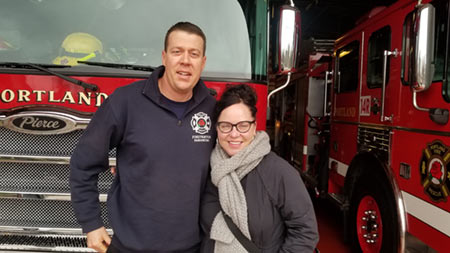
Oregon’s wet, cold winters bring Concordians inside our homes craving the crackling warmth of our fireplaces and woodstoves.
Data from the U.S. Fire Administration show the threat of winter fires is real. I am a burn specialist who cares for survivors of burn injuries.
I am also a person who experienced the humbling reality of my own home catching fire. Thank you to Portland Fire & Rescue Station 14 in Concordia for saving my life and home.
Nationwide in 2017, one person died every three hours and 20 minutes in a house fire. Other fires caused a death every two hours. According to the National Fire Incident Reporting System, heating equipment is the culprit of one in four Oregon winter house fires and a leading cause of winter house fire deaths.
Another leading cause of house fires is cooking appliances. Evening – 5 to 8 p.m. – is the most common time for these fires. So how can we protect our homes and loved ones?
Theresa McSherry FNP-C is a burn specialist, board certifed family nurse practitioner. She pract ices at The Oregon Clinic Surgical Burn Specialists, Legacy Emanuel Oregon Burn Center and the Legacy Wound and Burn Clinic. Theresa has lived in Concordia for 25 years and has loved watching it grow into the vibrant community it has become.